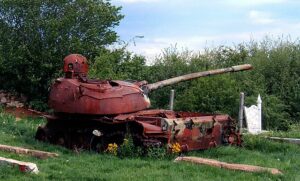In this second part of three articles taken from the historical background of Souvenirs from Kiev, I am focusing on the policies enacted upon Ukraine by Hitler and Stalin.
The Blitzkrieg
On August 23, 1939, Adolf Hitler and Joseph Stalin agreed on a Non-Aggression Pact through their representatives Ribbentrop and Molotov. It guaranteed that, should Hitler invade Poland, the USSR would not be attacked. In fact, Stalin was offered the lands of Ukraine under then-Polish rule, whose provision actually unified—for the first time—the territories of Galicia and the eastern states with the rest of Ukraine. Almost 4.5 million Ukrainians lived in those areas and the country became known as the Ukrainian SSR.
In return, Stalin agreed to supply Germany with essential war supplies and did so right up until the day Germany invaded the USSR in its Blitzkrieg on June 22, 1941.

Hitler’s Wehrmacht, the German Army, contained over 3 million troops and, when it attacked and crossed the Ukrainian SSR borders, cities such as L’viv, Kiev, and Odessa hardly resisted. Although Stalin had been warned of the impending attack for weeks, he had not reacted, and those cities submitted to the powerful German forces. They submitted because the Ukrainians also believed that the German Army would help liberate their country from the Communist regime—a regime that had instigated one of the most horrific man-made famines in history in which over seven million Ukrainians died in the early to mid-1930s.
The German Army was surprised when the Ukrainians welcomed them with traditional wreaths of flowers, bread and salt; buried their dead; and actually wept with relief.There were other reasons why the Ukrainians feared for their well-being. In the late 1930s, thousands from the intelligentsia were arrested and started to disappear, including writers, artists, musicians and even priests, whose nationalism was a great threat to the Soviet secret police (the NKVD). This period became known as the “Executed Renaissance” or rozstrilaniy vidrodzhennia. In addition, both official Ukrainian churches—the Catholic and the Orthodox—were forced underground as the Kremlin banned them and only permitted the practice of the Russian Orthodox denomination under the repressive regime. Indeed, Ukrainians viewed Germany as a cultured nation when they had to compare it to the Russian, especially when Hitler allowed religion to be openly practiced again (though this, too, was short-lived).

The Ukrainians were so thoroughly disenchanted with the Soviet Union that, in 1941 in the Battle of Kiev, over 98 per cent of the Red Army’s Ukrainian soldiers were willingly captured, believing that they would be allowed to serve in the German Army and free their country. It was a strange situation for those who fought in that battle. Ostarbeiter—the once-volunteer-turned-slave workers who were employed in German labor camps at the start of the war—were recruited by the Wehrmacht to fight on the front lines of the Blitzkrieg. By the time the armies had advanced on Kiev, the battle makeup was Ukrainians fighting Ukrainians over their own capitol.
As fate would have it, the Nazis had already called for the murder of those soldiers who deserted the Red Army, and they were intentionally starved to death or died of exposure in open-air concentration camps in the winter of 1941–42. It took the German Army only two weeks before they began openly persecuting the Ukrainian nation.
Scorched Earth Policy
Both Hitler and Stalin were adamant about having the riches of Ukraine, also known as the “Breadbasket of Europe.” Hitler had lofty plans for creating a rural “utopia” for his German nation in his plan to expand the supreme race’s Lebensraum. Stalin, already familiar with the country’s offerings, had razed the collective farms and had ample stock and slaves for mining the minerals and coals hidden under the soil. However, Stalin was the first to instigate a “scorched earth policy” wherein he demanded that, “in case of forced retreat… all rolling stock must be evacuated, the enemy must not be left a single engine, a single railway car, not a single pound of grain or gallon of fuel. The collective farmers must drive off all their cattle and turn over their grain to the safe keeping of the state authorities for transportation to the rear. All valuable property, including non-ferrous metals, grain and fuel that cannot be withdrawn, must be destroyed without fail. In areas occupied by the enemy, “…guerrilla units must set fire to forests, stores and transports.”





